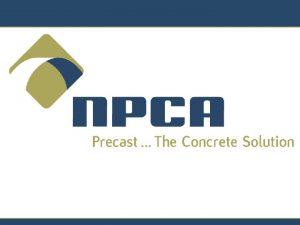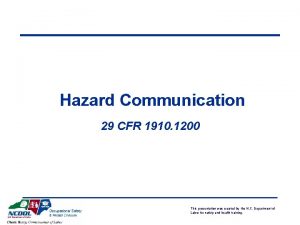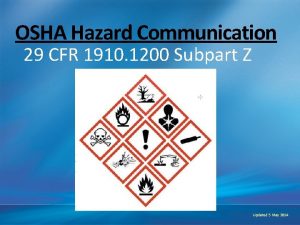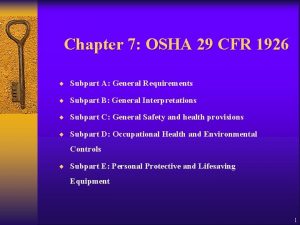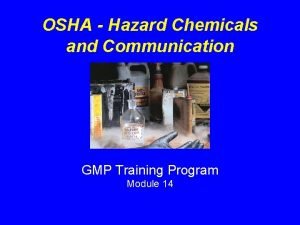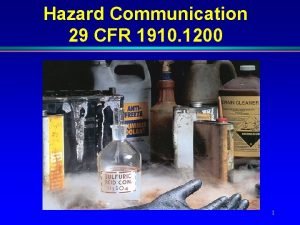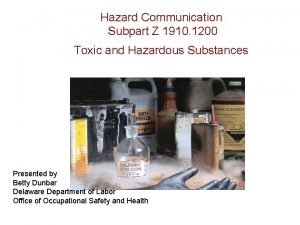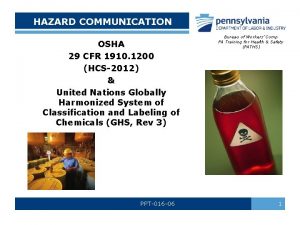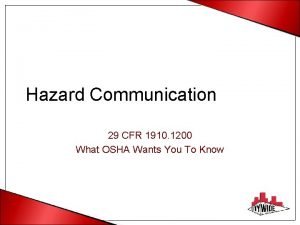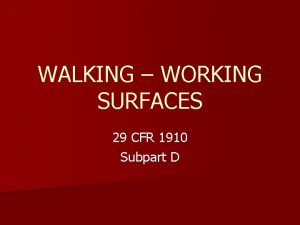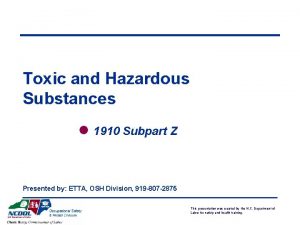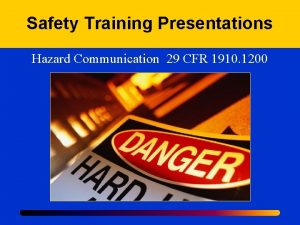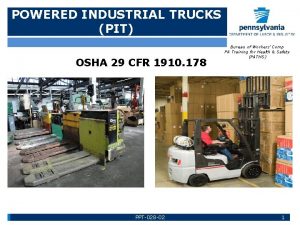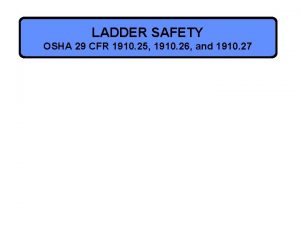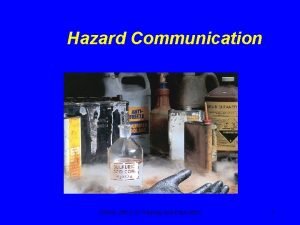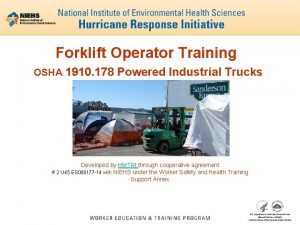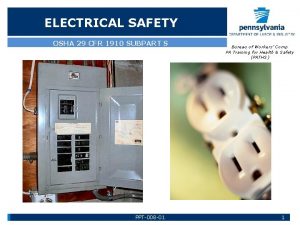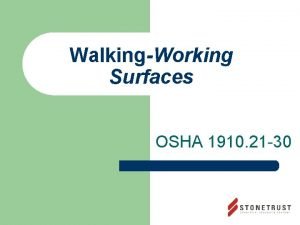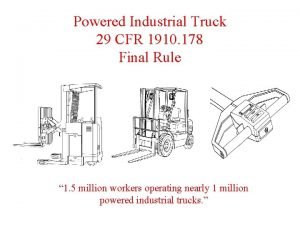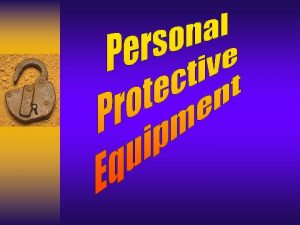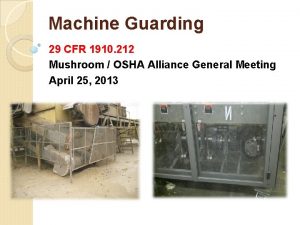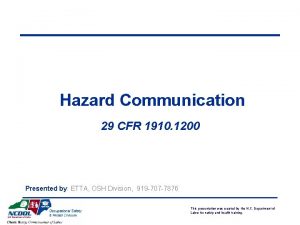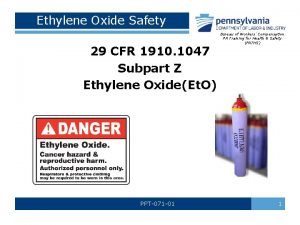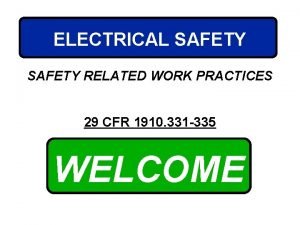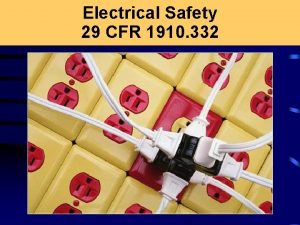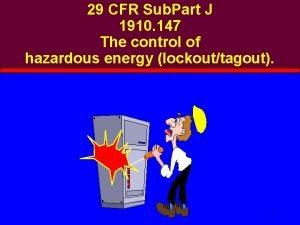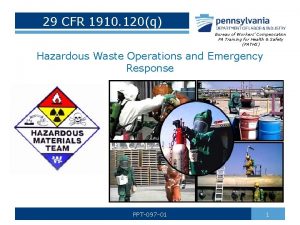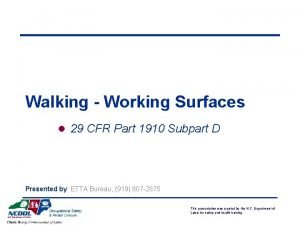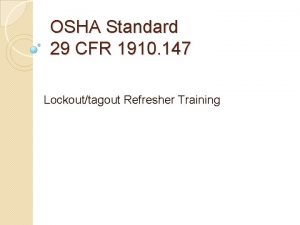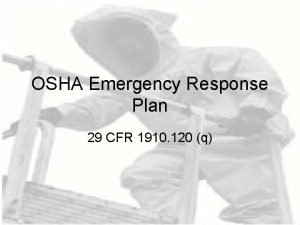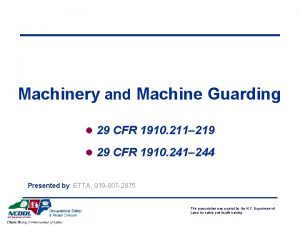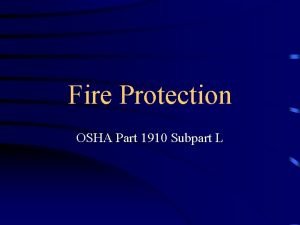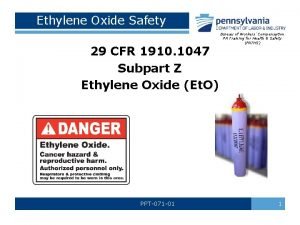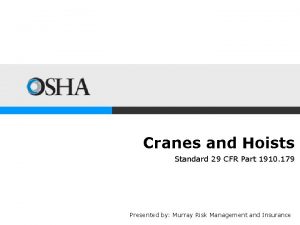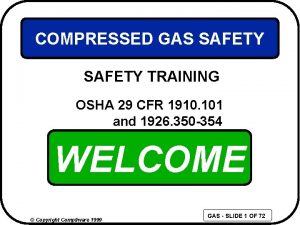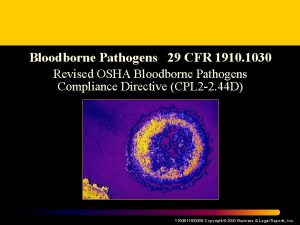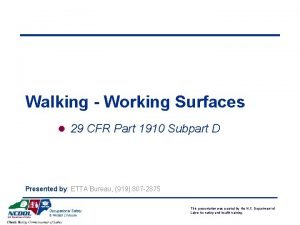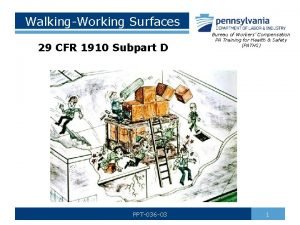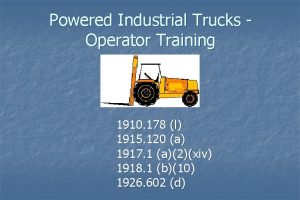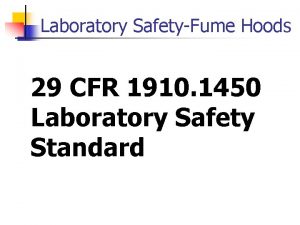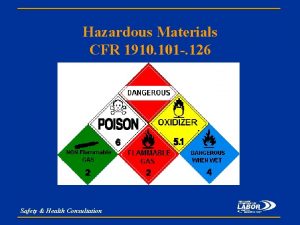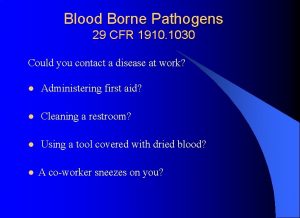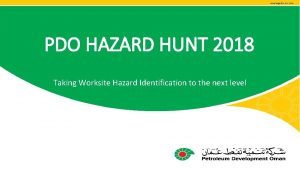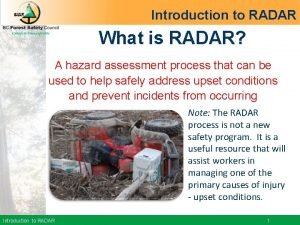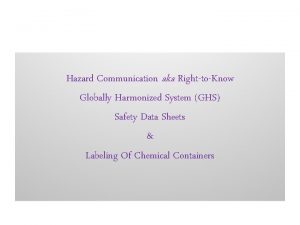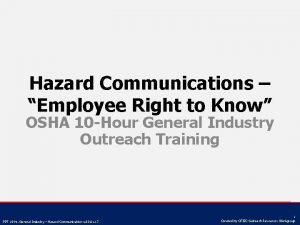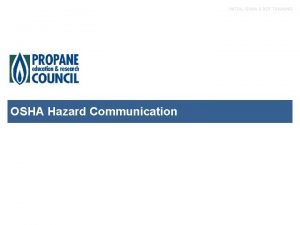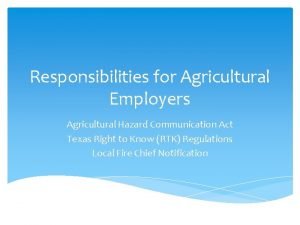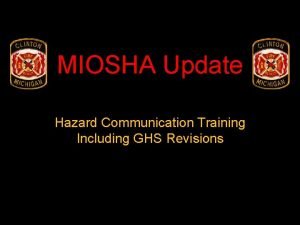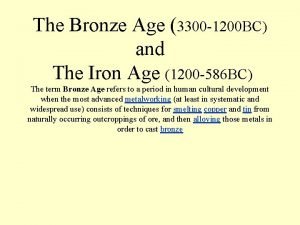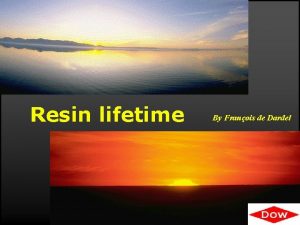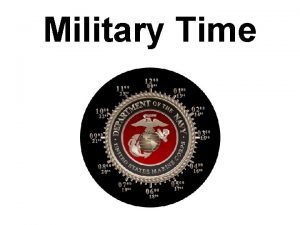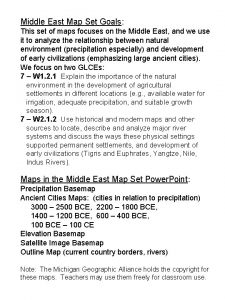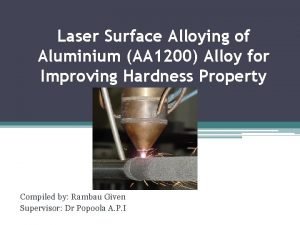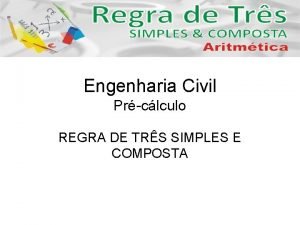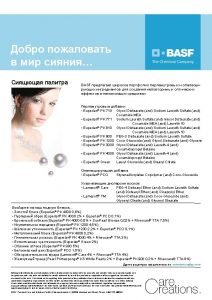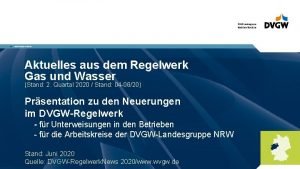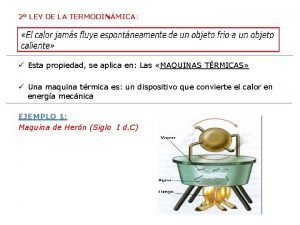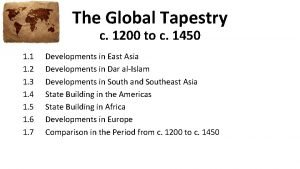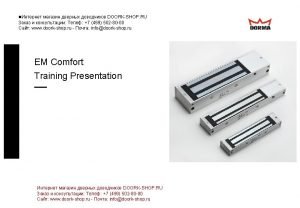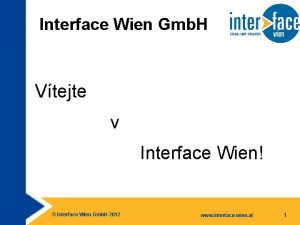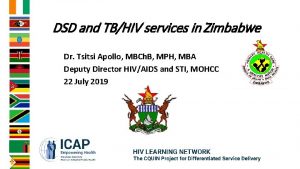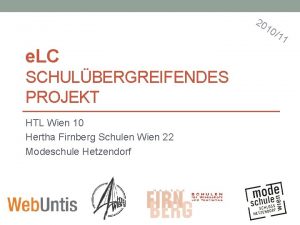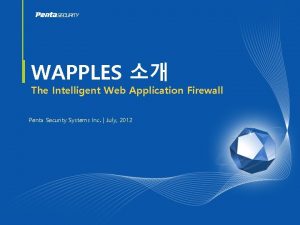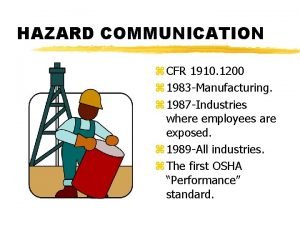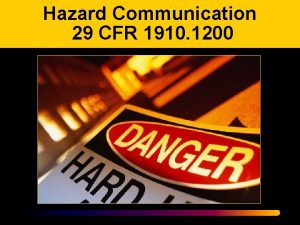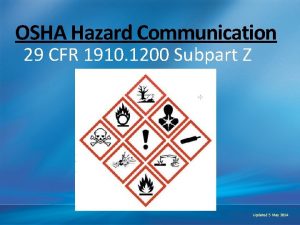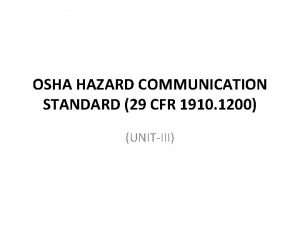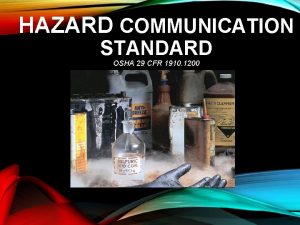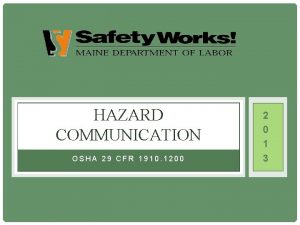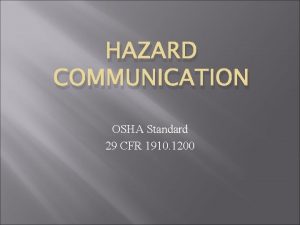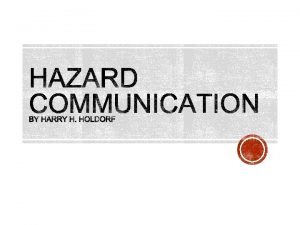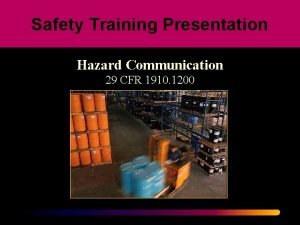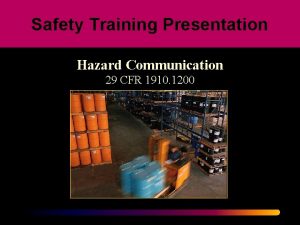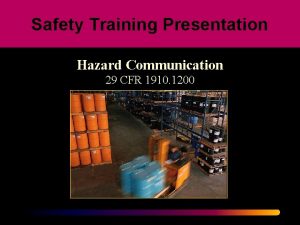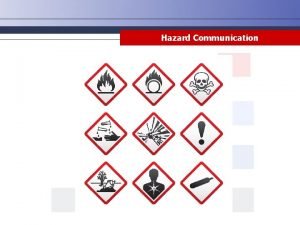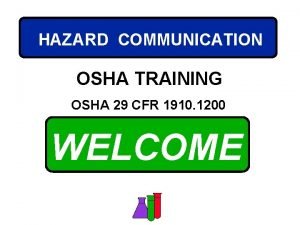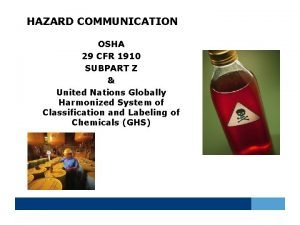Hazard Communication 29 CFR 1910 1200 This presentation








































































- Slides: 72

Hazard Communication 29 CFR 1910. 1200 This presentation was created by the N. C. Department of Labor for safety and health training.

Objectives 29 CFR 1910. 1200 l We will cover: - Purpose of hazard communication in the workplace - Role management and employees play in complying with this standard - General requirements regarding chemical hazards - Requirements for an effective written hazard communication program This presentation was created by the N. C. Department of Labor for safety and health training.

Organization of the Final Rule (a) Purpose (b) Scope and Application (c) Definitions (d) Hazard Classification (e) Written Hazard Communication Program (f) Labels and Other Forms of Warning (g) Safety Data Sheets (h) Employee Information and Training (i) Trade Secrets (j) Effective Dates This presentation was created by the N. C. Department of Labor for safety and health training.

Appendixes l Appendix A, Health Hazard Criteria (Mandatory) – NEW l Appendix B, Physical Criteria (Mandatory) – NEW l Appendix C, Allocation of Label Elements (Mandatory) – NEW l Appendix D, Safety Data Sheets (Mandatory) – NEW l Appendix E, Definition of “Trade Secret” (Mandatory) l Appendix F, Guidance for Hazard Classifications Re: Carcinogenicity (Non-Mandatory) – NEW This presentation was created by the N. C. Department of Labor for safety and health training.

Purpose 1910. 1200(a) l Ensure hazards of all chemicals produced or imported are classified and that information concerning the classified hazards is transmitted to employers and employees Classified Chemical Hazards This presentation was created by the N. C. Department of Labor for safety and health training.

Scope and Application 1910. 1200(b)(1) l Requires chemical manufacturers or importers to classify the hazards of chemicals that they produce or import l Requires distributors to transmit the required information to employers Transmit Information This presentation was created by the N. C. Department of Labor for safety and health training.

Scope and Application 1910. 1200(b)(1) l Requires employers to provide information to their employees about the hazardous chemicals to which they are exposed by the following means: - Hazard communication (Haz. Com) program - Labels and other forms of warning - Safety data sheets (SDS) - Information and training This presentation was created by the N. C. Department of Labor for safety and health training.

Scope and Application 1910. 1200(b)(2) l Applies to chemicals known to be present in the workplace l Employees that may have a potential for exposure - Under normal conditions or Nova Development - Foreseeable emergency This presentation was created by the N. C. Department of Labor for safety and health training.

Scope and Application 1910. 1200(b)(3) l Application for laboratories only - Labels are not to be removed or defaced - Maintain SDS for each chemical - SDS must be readily available - Provide information and training » Except location and availability of Haz. Com program l A laboratory that ships chemicals is considered to be a distributor or manufacturer: - Must ensure that containers are appropriately labeled prior to shipment, and - SDS is provided to other distributor(s) or employer(s) This presentation was created by the N. C. Department of Labor for safety and health training.

Scope and Application 1910. 1200(b)(4) l Application for work operations where chemicals are handled only in sealed containers - Labels not to be removed or defaced - Maintain SDS for each chemical - SDS must be readily accessible - Provide information and training » Except location and availability of Haz. Com program » Trained to protect themselves in the event of a spill or leak This presentation was created by the N. C. Department of Labor for safety and health training.

Scope and Application 1910. 1200(b)(5) l Exemptions for labeling - Pesticides (Federal insecticide, fungicide, and rodenticide Act 7 U. S. C. 136) - Chemical Substance or mixture (Toxic Substances Control Act 15 U. S. C. 2601 et seq. ) - Food, food additive, color additive (FDA 21 U. S. C. 301) - Cosmetic, medical or vet device (FDA 21 U. S. C. 301) - Distilled spirits (Federal Alcohol Administration Act 21 U. S. C. 201) - Consumer products (Consumer Product Safety Act 15 U. S. C. 2501) - Agricultural or vegetable seed (Federal Seed Act 7 U. S. C. 1551) This presentation was created by the N. C. Department of Labor for safety and health training.

Scope and Application 1910. 1200(b)(6) l Standard does not apply to: - Hazardous wastes and substances - Tobacco or tobacco products - Wood or wood products - Articles as defined in the standard - Food or alcoholic beverages - Drugs This presentation was created by the N. C. Department of Labor for safety and health training.

Scope and Application 1910. 1200(b)(6) l Standard does not apply to: - Cosmetics for retail sale - Consumer products - Nuisance particulates - Ionizing and nonionizing radiation - Biological hazards This presentation was created by the N. C. Department of Labor for safety and health training.

Key Elements of Haz. Com 1910. 1200 l Hazard classification l Written program l Labeling l SDS l Employee training This presentation was created by the N. C. Department of Labor for safety and health training.

Definitions 1910. 1200(c) l “Chemical” - Any substance or mixture of substances l “Substance” - Chemical elements and their compounds in the natural state or obtained by any production process This presentation was created by the N. C. Department of Labor for safety and health training.

Definitions 1910. 1200(c) l “Hazardous chemical” - Any chemical that is classified as a » Physical hazard » Health hazard » Simple asphyxiant » Combustible dust » Pyrophoric gas » Hazard not otherwise classified This presentation was created by the N. C. Department of Labor for safety and health training.

Definitions 1910. 1200(c) l “Physical hazard” - A chemical classified as posing one of the following hazardous effects: » » » » » Explosive Oxidizer (liquid, solid or gas) Self-reactive Pyrophoric (liquid or solid) Self-heating Organic peroxide What’s the hazard? Corrosive to metal Gas under pressure Emits flammable gas in contact with water Flammable (gases, aerosols, liquids or solids) This presentation was created by the N. C. Department of Labor for safety and health training.

Definitions 1910. 1200(c) l “Health hazard” − A chemical that is classified as posing one of the following hazardous effects: » » » » Acute toxicity (any route of exposure) Skin corrosion or irritation Serious eye damage or eye irritation Respiratory or skin sensitization Germ cell mutagenicity Carcinogenicity Reproductive toxicity Specific target organ toxicity (single or repeated exposure) » Aspiration hazard This presentation was created by the N. C. Department of Labor for safety and health training.

Definitions 1910. 1200(c) l “Pyrophoric gas” - A chemical in a gaseous state that will ignite spontaneously in air at a temperature of 130 degrees F (54. 4 degrees C) or below Arsine Gas (As. H 3) This presentation was created by the N. C. Department of Labor for safety and health training.

Definitions 1910. 1200(c) l “Simple asphyxiant” - A substance or mixture that displaces oxygen in the ambient atmosphere and can cause oxygen deprivation in those who are exposed, leading to unconsciousness and death This presentation was created by the N. C. Department of Labor for safety and health training.

Definitions 1910. 1200(c) l “Hazard not otherwise classified (HNOC)” - An adverse physical or health effect identified through evaluation of scientific evidence during the classification process that does not meet the specified criteria for the physical and health hazard classes addressed in this section (standard) - The effect either: » Falls below the cut-off value/concentration limit of this hazard class, or » Is under a GHS hazard category not adopted by OSHA (e. g. , acute toxicity Category 5) This presentation was created by the N. C. Department of Labor for safety and health training.

Hazard Classification 1910. 1200(d) l Each type of hazard covered is considered a “hazard class” - Examples: acute toxicity, carcinogenicity l Most hazard classes are also subdivided into “hazard categories” to reflect the degree of severity of the effect l This is the concept of “classification”—rather than just determining that there is a hazardous effect (e. g. , carcinogenicity), there is also a finding of how severe that effect might be (e. g. , category 1 or 2) This presentation was created by the N. C. Department of Labor for safety and health training.

Hazard Classification 1910. 1200(d) l Those that evaluate chemicals must follow procedures in Appendixes “A” and “B” l When classifying mixtures, manufacturers/ importers may rely on SDS for individual ingredients unless SDS known to omit or misstate required information l Employers are not required to classify chemicals This presentation was created by the N. C. Department of Labor for safety and health training.

Appendix A - Health Hazard Criteria l OSHA adopted all of the health hazard classes in the GHS—the criteria to define each of these are found in Appendix A—Health Hazard Criteria (Mandatory) l However, the agency did not adopt the following hazard categories: - Acute toxicity: Category 5 - Skin corrosion/irritation: Category 3 - Aspiration hazard: Category 2 This presentation was created by the N. C. Department of Labor for safety and health training.

This presentation was created by the N. C. Department of Labor for safety and health training.

Mixtures Appendix A. 0. 4 -0. 5 l Uses a tiered approach to mixtures, with each health hazard class having a specific approach - Step 1: Use available test data on the mixture as a whole to classify the mixture based on the substance criteria - Step 2: Use bridging principles to extrapolate from other data (e. g. , dilution principle) - Step 3: Estimate hazards based on known information regarding the ingredients of the mixture (cut-offs may be applied) l Chemical manufacturers and importers may rely on the information provided in ingredient SDSs unless they have a reason to know that it is inaccurate This presentation was created by the N. C. Department of Labor for safety and health training.

Carcinogenicity Appendix A. 6 l For carcinogens - OSHA is allowing classifiers to use determinations of Internal Agency for Research on Cancer (IARC) and National Toxicology Program (NTP) for classification or to perform their own hazard evaluation - New Appendix F (Non-mandatory) » Guidance for Hazard Classifications Regarding Carcinogenicity This presentation was created by the N. C. Department of Labor for safety and health training.

Appendix B – Physical Criteria l The physical hazard criteria in Appendix B— Physical Criteria (Mandatory) are based on the United Nation (UN) Recommendations for the Transport of Dangerous Goods, and are already used by the Department of Transportation (DOT) in hazardous materials regulations l OSHA has adopted the GHS criteria for all physical hazards This presentation was created by the N. C. Department of Labor for safety and health training.

This presentation was created by the N. C. Department of Labor for safety and health training.

Written Program 1910. 1200(e)(1) & (4) l Employer must have a written hazard communication program l It must be available upon request to: - Employees and/or their designated representative - OSHA This presentation was created by the N. C. Department of Labor for safety and health training.

Written Program 1910. 1200(e) l Must contain how the following will be met: - Labels and other forms of warning - Safety data sheets - Information and training - List of chemicals This presentation was created by the N. C. Department of Labor for safety and health training.

Written Program 1910. 1200(e)(1)(ii) l Must also contain: - Methods used to inform employees of the hazards associated with non-routine tasks » Example: cleaning a reactor vessel - Hazards associated with chemicals contained in unlabeled pipes in the workplace This presentation was created by the N. C. Department of Labor for safety and health training.

Written Program 1910. 1200(e)(2) l Multi-employer workplaces - Methods used to inform other employer(s): » SDS access » Precautionary measures during normal operating conditions and in foreseeable emergencies » Labeling system (in-house or workplace labeling) This presentation was created by the N. C. Department of Labor for safety and health training.

Written Program 1910. 1200(e)(5) l When employees travel between workplaces during a work shift (their work is carried out at more than one geographical location) - Haz. Com program may be kept at a primary workplace facility This presentation was created by the N. C. Department of Labor for safety and health training.

Labeling 1910. 1200(c) l “Label” - An appropriate group of written, printed or graphic information elements concerning a hazardous chemical that is affixed to, printed on, or attached to the immediate container of a hazardous chemical, or to the outside packaging This presentation was created by the N. C. Department of Labor for safety and health training.

Labeling 1910. 1200(f) l Must be in English and prominently displayed: - Product identifier - Signal word - Hazard statements - Pictogram(s) - Precautionary statement(s) - Name, address and telephone number of manufacturer/importer/responsible party This presentation was created by the N. C. Department of Labor for safety and health training.

Harmonized Information l Signal words, pictograms and hazard statements have been harmonized and assigned to each hazard class and category in the GHS l Once a chemical has been classified, the label preparer can obtain the relevant harmonized information from Appendix C—Allocation of Label Elements (Mandatory) This presentation was created by the N. C. Department of Labor for safety and health training.

Harmonized Information Danger vs Warning l “Signal word” - A word used to indicate the relative level of severity of hazard and alert the reader to a potential hazard on the label - “Danger” is used for the more severe hazards - “Warning” is used for the less severe This presentation was created by the N. C. Department of Labor for safety and health training.

Hazard Statements l “Hazard statement” - A statement assigned to a hazard class and category that describes the nature of the hazard(s) of a chemical, including, where appropriate, the degree of hazard - Example: Harmful if inhaled (for Category 4 Acute Toxicity - Inhalation) Pictogram Mancomm © Signal word Danger Warning Hazard statement Fatal if inhaled Toxic if inhaled Harmful if inhaled This presentation was created by the N. C. Department of Labor for safety and health training.

Pictograms l “Pictogram” means a composition that may include a symbol plus other graphic elements, such as a border, background pattern or color, that is intended to convey specific information about the hazards of a chemical - Eight pictograms are designated under this standard for application to a hazard category Mancomm © This presentation was created by the N. C. Department of Labor for safety and health training.

Mancomm © This presentation was created by the N. C. Department of Labor for safety and health training.

Pictograms l Red borders required Mancomm © l No blank pictograms Mancomm © This presentation was created by the N. C. Department of Labor for safety and health training.

Precautionary Statements l “Precautionary statement” means a phrase that describes recommended measures that should be taken to minimize or prevent adverse effects resulting from exposure to a hazardous chemical, or improper storage or handling - Example for Explosives, Division 1. 1, 1. 2 and 1. 3 » Keep away from heat/sparks/open flames/hot surfaces. No smoking » Keep wetted with… » Ground/bond container and receiving equipment » Do not subject to grinding/shock/…/friction » Wear face protection This presentation was created by the N. C. Department of Labor for safety and health training.

Precautionary Statements l OSHA has adopted the precautionary statements from the GHS - Statements are in Appendix C—Allocation of Label Elements, and assigned to classes and categories - Also provides better consistency and comprehensibility than allowing the development of company-specific statements l Rule provides flexibility for precautionary and hazard statement application This presentation was created by the N. C. Department of Labor for safety and health training.

Additional Requirements l Harmonized information is to be provided together on the label - Signal words, pictograms and hazard statements l All information is to be prominently displayed and in English (although other languages may also be provided) l Requirement that information not conflict with transport labels remains the same This presentation was created by the N. C. Department of Labor for safety and health training.

Example of Appendix C Label Elements Mancomm © This presentation was created by the N. C. Department of Labor for safety and health training.

Updating Labels l HCS 1994 required labels to be updated within three months but a stay prevented OSHA from enforcing this requirement l This rulemaking removes the stay - Labels are to be updated within six months of getting new and significant information about the hazards or ways to protect those exposed This presentation was created by the N. C. Department of Labor for safety and health training.

Label Example This presentation was created by the N. C. Department of Labor for safety and health training.

Labeling 1910. 1200(f) l Solid materials - Solid metal, wood or plastic items not exempted as articles due to downstream use » Label must be transmitted to customer with initial shipment » Does not apply to any chemicals used with or present with materials to which employees may be exposed by handling • Examples: cutting fluids, pesticides This presentation was created by the N. C. Department of Labor for safety and health training.

Labeling 1910. 1200(f)(6) l Workplace labeling - Each hazardous chemical container must be labeled, tagged or marked with either » Information required for labels on shipped containers Or » Product identifier and words, pictures, symbols, or combination thereof, which provide at least general information regarding the hazards of the chemicals (In conjunction with the other information immediately available to employees under the hazard communication program) This presentation was created by the N. C. Department of Labor for safety and health training.

Labeling 1910. 1200(f)(8) l Labeling exemption - Portable containers that are intended for immediate use by the employee who performs the transfer of hazardous chemical from a labeled container - Immediate use » Under the control of, and Unlabeled and Uncontrolled Portable Container » Used only by the employee, and » Within the work shift of transfer This presentation was created by the N. C. Department of Labor for safety and health training.

Safety Data Sheets 1910. 1200(g) l “Safety Data Sheet (SDS)” - Written or printed material concerning a hazardous chemical that is prepared in accordance with paragraph (g)—Safety Data Sheets This presentation was created by the N. C. Department of Labor for safety and health training.

Safety Data Sheets 1910. 1200(g) l Chemical manufacturers and importers must obtain or develop an SDS l Employers must have an SDS in the workplace for each chemical they use l Must be in English This presentation was created by the N. C. Department of Labor for safety and health training.

Safety Data Sheets 1910. 1200(g) l 16 -section safety data sheet l Several sections are not mandatory since they address information outside OSHA’s jurisdiction (Sections 12 -15) l Appendix D—Safety Data Sheets (Mandatory) provides the details of what is to be included in each section l No subheading in Sections 1 -11 and 16 can be left blank This presentation was created by the N. C. Department of Labor for safety and health training.

Safety Data Sheet Format 1910. 1200(g) 1. Identification of the substance or mixture and of the supplier 2. Hazards identification 3. Composition/information on ingredients 4. First-aid measures 5. Fire-fighting measures 6. Accidental release measures 7. Handling and storage 8. Exposure controls/personal protection 9. Physical and chemical properties 10. Stability and reactivity 11. Toxicological information 12. Ecological information (non-mandatory) 13. Disposal considerations (non-mandatory) 14. Transport information (non-mandatory) 15. Regulatory information (non-mandatory) 16. Other information, including date of preparation or last revision This presentation was created by the N. C. Department of Labor for safety and health training.

Safety Data Sheets 1910. 1200(g) l Chemical manufacturers or importers must ensure that distributors and employers are provided an appropriate SDS - With their initial shipment, and - With the first shipment after an SDS is updated This presentation was created by the N. C. Department of Labor for safety and health training.

Safety Data Sheets 1910. 1200(g) l SDS access for employees - Readily accessible - During work shift l Electronic and other alternatives are acceptable - No barriers to immediate employee access l When employees travel between workplaces during a work shift - May be kept at primary workplace This presentation was created by the N. C. Department of Labor for safety and health training.

Employee Exposure Records 1910. 1200(g)(11) l References 1910. 1020—Access to Employee Exposure and Medical Records - An “employee exposure record” includes Material Safety Data Sheets (MSDS)* - In the absence of an MSDS, a chemical inventory - Must be held and maintained at least 30 years - Employee access to record * The 3/26/2012 final rule did not include a revision to 1910. 1020 This presentation was created by the N. C. Department of Labor for safety and health training.

Information and Training 1910. 1200(h) l Training provided to employees upon: - Initial employment - When new hazards are introduced into the workplace l Information - Requirements of this section - Operations in their work area where hazardous chemicals are present - Location and availability: • Written hazard communication program • List(s) of hazardous chemicals • Safety data sheets This presentation was created by the N. C. Department of Labor for safety and health training.

Information and Training 1910. 1200(h) l Training - Methods and observations to detect presence or release of chemicals - Physical, health, simple asphyxiation, combustible dust and pyrophoric gas hazards - Hazards not otherwise classified - Measures to protect themselves - Details of the hazard communication program: » An explanation of the labeling system » Safety data sheets » How employees can obtain/use the appropriate hazard information This presentation was created by the N. C. Department of Labor for safety and health training.

Trade Secrets 1910. 1200(i) l Under the N. C. Right to Know Act (NCGS 95 - 173, Article 18), hazard information on chemicals deemed as a trade secret are to be provided to the local fire chief, who must hold the information in confidence l Chemical manufacturers, importers or employers may withhold specific information from the SDS - They must be able to support that the information withheld is a trade secret This presentation was created by the N. C. Department of Labor for safety and health training.

Trade Secrets 1910. 1200(i)(2) l Emergencies - Where a treating physician or nurse determines that a medical emergency exists, the chemical identity and/or specific percentage of the composition of the trade secret must be disclosed Medical Emergency This presentation was created by the N. C. Department of Labor for safety and health training.

Trade Secrets 1910. 1200(i)(3) l Non-emergencies - Disclose to health professional if: » Requested in writing; and » Describes one or more occupational health need • Used to assess an employee’s exposure • Provide medical treatment • Design engineering controls • Assessing hazards • Conducting medical surveillance • Assessing personal protective equipment • Conducting medical studies This presentation was created by the N. C. Department of Labor for safety and health training.

Effective Dates 1910. 1200(j) Effective Completion Date Requirement(s) Who December 1, 2013 Train employees on the new label elements and safety data sheet (SDS) format. Employers June 1, 2015* Compliance with all modified provisions of this final rule, except: Chemical manufacturers, importers, distributors and employers December 1, 2015 The Distributor shall not ship containers labeled by the chemical manufacturer or importer unless it is a GHS label. June 1, 2016 Update alternative workplace labeling and hazard communication program as necessary, and provide additional employee training for newly identified physical or health hazards. Transition Period to the effective completion May comply with either 29 CFR dates noted above. 1910. 1200 (the final standard), or the current standard, or both. Employers Chemical manufacturers, importers, distributors, and employers Mancomm © During the transition period after the final rule is promulgated, either the HCS 1994 or the new final rule (HCS 2012) can be followed This presentation was created by the N. C. Department of Labor for safety and health training.

Changes Affecting the Workplace l Employers - Training on label elements - pictograms, signal words, hazard statements and precautionary statements - Training on new SDS format - Continue to maintain the updated SDSs l Manufacturers - Initial start-up costs associated with reclassification, producing new labels, safety data sheets and training This presentation was created by the N. C. Department of Labor for safety and health training.

Other Affected Standards l Many other OSHA standards contain criteria related to defining hazards, as well as other provisions, that rely on those criteria - OSHA undertook a comprehensive review of its rules to identify what needed to be changed - OSHA maintained the scope of existing standards This presentation was created by the N. C. Department of Labor for safety and health training.

Other Affected Standards l Standards affected ranged from comprehensive rules, such as that addressing flammable liquids, to the label and sign provisions of substance-specific health standards l In the rulemaking, OSHA modified all standards that needed to be consistent with HCS 2012 - Included all the substance-specific standards as well as many safety standards that involve physical hazards This presentation was created by the N. C. Department of Labor for safety and health training.

Examples of Harmonized Changes to Other Standards Affected by the GHS Revision This presentation was created by the N. C. Department of Labor for safety and health training.

Flammable Liquids – 29 CFR 1910. 106 l HCS 1994 − Paragraph (b)(2)(iv)(g) - Flame arresters or venting devices required in paragraph (f) may be omitted for Class IB and IC liquids where conditions are such that their use may, in case of obstruction, result in tank damage l HCS 2012 − Paragraph (b)(2(iv)(g) - Flame arresters or venting devices required in paragraph (b)(2)(iv)(f) of this section may be omitted for Category 2 flammable liquids and Category 3 flammable liquids with a flashpoint below 100 F (37. 8 C) where conditions are such that their use may, in case of obstruction, result in tank damage Note: In 1926. 152, same changes to paragraph (i)(2)(iv)(F) and (i)(2)(iv)(G). This presentation was created by the N. C. Department of Labor for safety and health training.

PSM – 29 CFR 1910. 119(a)(1)(ii) l HCS 1994 − A process which involves a flammable liquid or gas (as defined in 1910. 1200(c) of this part) on site in one location, in a quantity of 10, 000 pounds (4, 535. 9 kg) l HCS 2012 − A process which involves a Category 1 flammable gas (as defined in 1910. 1200 (c)) or a flammable liquid with a flashpoint below 100 F (37. 8 C) on site in one location, in a quantity of 10, 000 pounds (4, 535. 9 kg) This presentation was created by the N. C. Department of Labor for safety and health training.

Updated Websites GHS Webpage: http: //www. osha. gov/dsg/Haz. Com/index. html Hazard Communication Webpage: http: //www. osha. gov/dsg/Haz. Com/index 2. html NCLABOR Webpage: http: //www. nclabor. com/osha/etta/A_to_Z_Topics/a_to_z_toc. htm This presentation was created by the N. C. Department of Labor for safety and health training.

Thank You For Attending! Final Questions? This presentation was created by the N. C. Department of Labor for safety and health training.
 Osha hazard communication standard 29 cfr 1910
Osha hazard communication standard 29 cfr 1910 29cfr1910 1200
29cfr1910 1200 Osha 1910 psm
Osha 1910 psm 29 cfr 1910 section 1200
29 cfr 1910 section 1200 Osha 29 cfr 1910 1200
Osha 29 cfr 1910 1200 Osha hazard and ghs training regulation cfr 1910
Osha hazard and ghs training regulation cfr 1910 29cfr1910.1200
29cfr1910.1200 Ghs explosive
Ghs explosive Hcs2012
Hcs2012 Specific hazard
Specific hazard D3ladder
D3ladder 29 cfr part 1910 subpart z
29 cfr part 1910 subpart z 29 cfr 1910
29 cfr 1910 Osha 1910 forklift
Osha 1910 forklift Osha 1910 ladders
Osha 1910 ladders Osha cfr 1910 is the standard for______.
Osha cfr 1910 is the standard for______. 29 cfr 1910 osha 178
29 cfr 1910 osha 178 Osha subpart s
Osha subpart s Osha 29 cfr 1910
Osha 29 cfr 1910 29cfr1910.178
29cfr1910.178 29cfr1910.132
29cfr1910.132 Osha 1910 machine guarding
Osha 1910 machine guarding 29 cfr1910.1200
29 cfr1910.1200 29 cfr 1910 powered industrial trucks
29 cfr 1910 powered industrial trucks 29cfr1910.1020
29cfr1910.1020 29 cfr 1910
29 cfr 1910 A person usually offers the most resistance to electricity
A person usually offers the most resistance to electricity 29 cfr 1910
29 cfr 1910 29 cfr1910.120
29 cfr1910.120 Osha 1910 guardrail
Osha 1910 guardrail 29 cfr 1910
29 cfr 1910 1910-120
1910-120 Cfr
Cfr Osha 1910 subpart l
Osha 1910 subpart l 49 cfr 1910
49 cfr 1910 29 cfr part 1910
29 cfr part 1910 29 cfr 1910 compressed gas cylinder storage
29 cfr 1910 compressed gas cylinder storage Bloodborne pathogens quiz answers
Bloodborne pathogens quiz answers Every open sided floor or platform
Every open sided floor or platform 1910 subpart s
1910 subpart s Osha 29 cfr 1910 subpart d
Osha 29 cfr 1910 subpart d 29 cfr 1910 osha 178
29 cfr 1910 osha 178 1910 ppe
1910 ppe 29 cfr 1910 osha 178
29 cfr 1910 osha 178 29 cfr 1910.
29 cfr 1910. Compressed gas association pamphlet p 1 1965
Compressed gas association pamphlet p 1 1965 29 cfr 1910 1030
29 cfr 1910 1030 Hazard hunt program
Hazard hunt program Assessing the situation
Assessing the situation Hazard communication quiz answers
Hazard communication quiz answers Hazard communication ppt
Hazard communication ppt Osha hazard communication inital training
Osha hazard communication inital training Texas hazard communication act
Texas hazard communication act Miosha hazard communication standard
Miosha hazard communication standard 3300/1200
3300/1200 Amberjet 1200 na
Amberjet 1200 na Yucatan peninsula on map of south america
Yucatan peninsula on map of south america Military time to regular time
Military time to regular time Anatolia map 1200
Anatolia map 1200 1200 alloy
1200 alloy Wwwama
Wwwama Uma empresa tem 750 empregados e comprou marmitas
Uma empresa tem 750 empregados e comprou marmitas Euperlan pk 810
Euperlan pk 810 Dvgw gw 1200
Dvgw gw 1200 Eficiencia de carnot
Eficiencia de carnot The global tapestry from c.1200 to c.1450
The global tapestry from c.1200 to c.1450 Sex 1200
Sex 1200 Emc 1200 alh
Emc 1200 alh Physics 1200
Physics 1200 Interface 1200 wien
Interface 1200 wien 400000/1200
400000/1200 Htl wien 20
Htl wien 20 Penta security web application firewall
Penta security web application firewall
